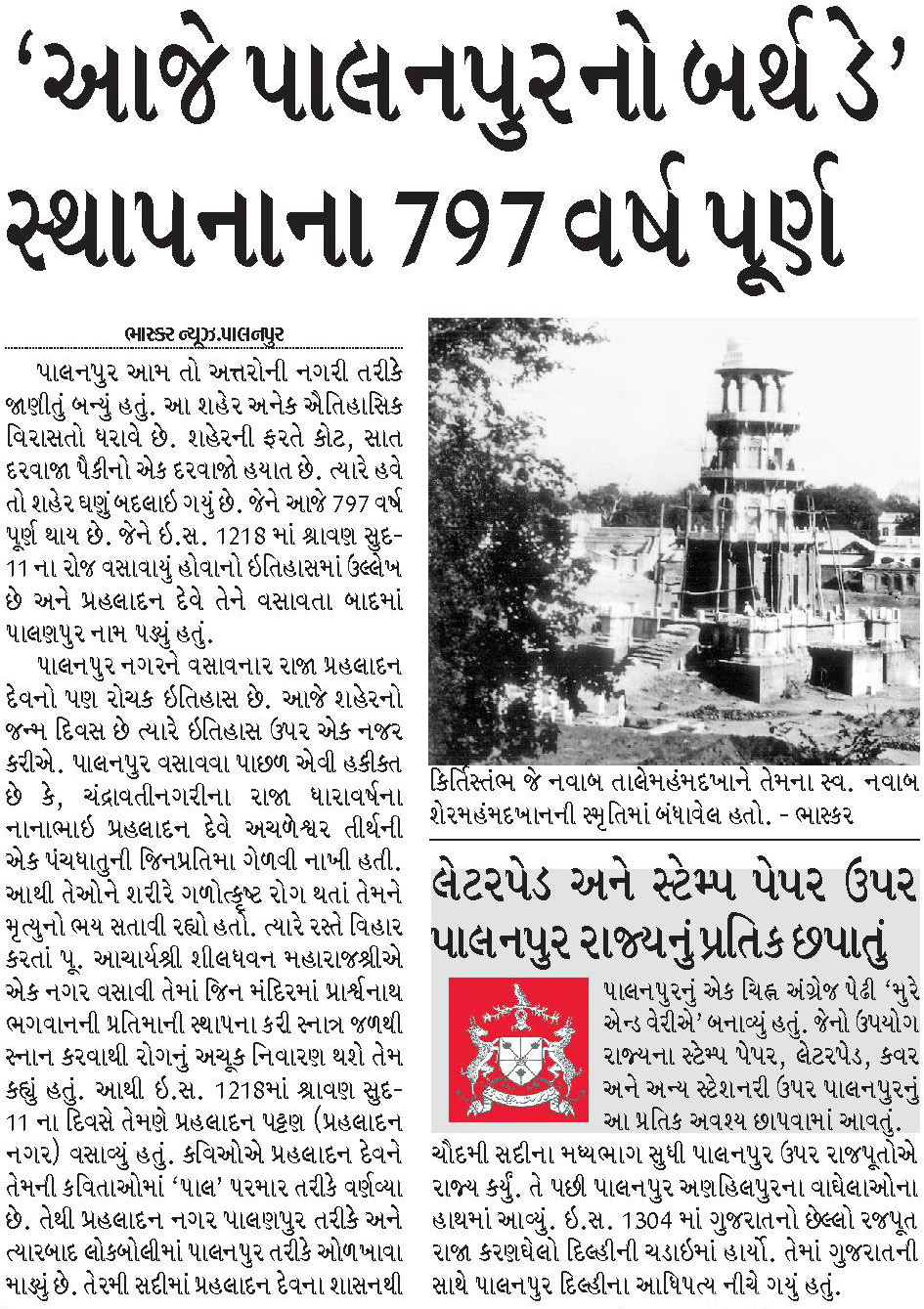
The town was once heavily fortified with seven Darwaja [Gate] in different directions, providing the only means of thoroughfare; these are now in ruins. Some of the gates known are called as follows "Shimla Darwaja", "Delhi Darwaja","VirBai Darwaja","Meera Darwaja" " Malan Darwaja" " Saalampur " and "Gathaman Darwaja". Of much more recent vintage are the other monuments that dot the town: the "Keertisthambh" or "victory tower" was erected in the 1930s, as were the zorawar palace(Currently used as Judicial Court) and the Balaram palace. The main old market places also called heart of Palanpuri is Nanibazar,Moti Bazar,Dhal vas etc. Palanpuri has beautiful gardens: Shashivan and Chaman Bag. Palanpuri has beautiful lake name " Maansarovar " Well known King Sidhdhraj Jaysinh of Patan town was born in the Palanpuri. Her Mother built Lord Shiva's "Pataleshwar Temple" of Palanpuri.
Palanpuri was the seat of a princely state ruled by the Lohani (Jhalore) Dynasty. It was a Salute state with the Nawab of Palanpuri having a hereditary salutes of 13-guns While the early history of the family is 'who established themselves in Bihar during the twelfth century and ruled there as Sultans. Malik Khurram Khan, the founder of the Palanpuri house, left Bihar and entered the service of Vishaldev of Mandore during the late fourteenth century. Appointed Governor of Songad or Jhalor, he took control of that place in the confusion that followed the death of the Mandore ruler;'[5] a forbearer of the family is reputed to have wed the foster-sister of the Mughal emperor Akbar and to have received Palanpuri and the surrounding areas as a dowry. However, the family comes into historical prominence during the period of instability that followed the demise of Aurangzeb in the early 18th century. It was overrun soon afterwards by the Marathas; the Lohanis followed the trend of seeking recourse in the British East India Company against them and finally entered the subsidiary alliance system in 1817, along with all other neighbouring states.
The state encompassed an area of 1766 km² (682 mi²) and a population, in 1901, of 222,627. The town of Bharwapur housed a population of only 8000 people that year. The state commanded a revenue of approximately Rs.50,000/- per year. It was traversed by the main line of the Rajputana-Malwa railway, and contained the British cantonment of Deesa. Wheat, rice and sugar-cane were the chief products. Watered by the Sabarmati river, the state was heavily forested in its northern reached (the present-day Jessore sanctuary) but undulating and open in the south and east. The country was on the whole somewhat hilly, being at the edge of the Aravalli Range.
Palanpuri State had its own flag. Whenever the army went to war, or the king led a procession, the flag would fly at the front as a symbol of the state. The flag of Palanpuri was light green, yellow and red, and unfurled into in a longish horizontal tricolour. This was the ‘State Flag of Palanpuri’, and continued to be so, upto its merger with the Indian Union. When Emperors George V and George VI held their courts in Delhi, each state flag was unfurled behind the seat meant for the head of each state. The Palanpuri flag was hoisted behind the seat of Palanpuri Nawab on such occasions.
Palanpuri Crest The Lohani Nawabs of Palanpuri used the Crest of Palanpuri state even when they ruled Jhalore. The crest was created by British company Murray and Wary, and has an Arabic inscription, which translates to: “With wisdom we took, with sword we protected”. The crest has a crown in the centre which is circled by lotuses. It is flanked on both sides by two deer, each standing on two feet, while supporting the shield with the other two. Above the deer, is the face of a soldier, dressed in armour, under a regal eagle. At the very bottom is a ribbon extending through the breadth of the shield. The crest was used on stamp papers, letterheads, and other official stationery used by the state. It was imprinted onto the shields of Palanpuri soldiers, and was also on the main gate of the palace.
